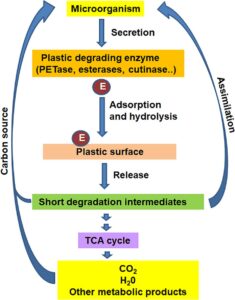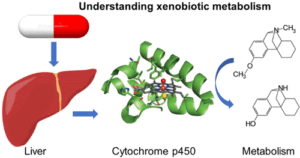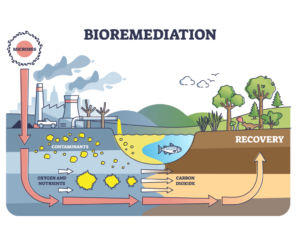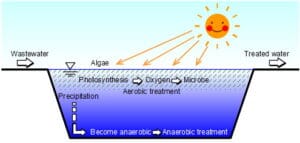In Situ Bioremediation
Definition:
In situ bioremediation is a process that involves the treatment of contaminated soil or groundwater directly at the site of contamination without the need to excavate the affected material. This method relies on microorganisms, such as bacteria, fungi, or plants, to break down pollutants into less toxic or harmless substances.
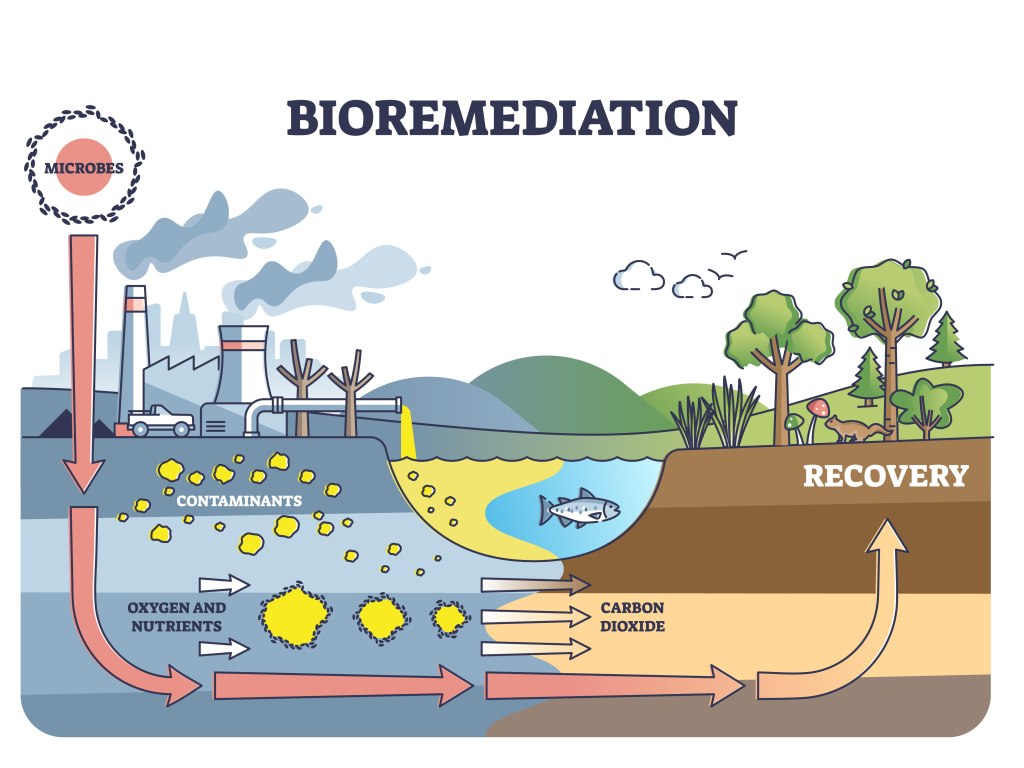
Principles of In Situ Bioremediation
- Microbial Action: Microorganisms degrade organic and inorganic pollutants through metabolic processes.
- Bioavailability: Contaminants must be accessible to microbes for effective breakdown.
- Environmental Optimization: Conditions like pH, temperature, oxygen levels, and nutrient availability must be optimized for microbial activity.

Types of In Situ Bioremediation Techniques
1. Intrinsic Bioremediation
- Relies on the natural activity of indigenous microorganisms to degrade contaminants.
- Suitable for sites where pollutants are biodegradable under existing conditions.
2. Enhanced Bioremediation
- Involves the addition of nutrients, oxygen, or other amendments to stimulate microbial growth and activity.
- Includes methods like:
- Bioventing: Injecting air or oxygen into the soil to promote aerobic degradation.
- Bioaugmentation: Adding specialized microbial strains to improve degradation rates.
- Biosparging: Introducing air into groundwater to facilitate contaminant breakdown.
3. Phytoremediation
- Utilizes plants to absorb, sequester, or degrade contaminants.
- Effective for heavy metals, hydrocarbons, and certain organic compounds.
Applications of In Situ Bioremediation
- Petroleum Hydrocarbons: Degradation of oil spills and gasoline residues.
- Chlorinated Compounds: Breakdown of solvents like trichloroethylene (TCE).
- Heavy Metals and Radionuclides: Stabilization or immobilization of metals like lead, cadmium, and uranium.
- Agricultural Runoff: Mitigation of nitrate and pesticide contamination in soil and groundwater.
Advantages
- Cost-Effective: Avoids costs associated with excavation and transportation of contaminated materials.
- Environmentally Friendly: Minimal disruption to the ecosystem.
- Wide Applicability: Can address a variety of contaminants.
- Sustainability: Promotes natural processes for long-term site restoration.
Limitations
- Time-Intensive: May take years to achieve significant remediation.
- Site-Specific Conditions: Requires favorable conditions for microbial activity.
- Limited Effectiveness: Not suitable for all contaminants or high concentrations.
- Monitoring Challenges: Ensuring efficiency and effectiveness can be complex.
In situ bioremediation is a promising approach for addressing environmental pollution sustainably. By leveraging natural processes, it minimizes environmental disruption and is cost-effective. However, successful implementation requires careful assessment of site conditions, contaminant properties, and microbial capabilities to ensure effective remediation.
Ex Situ Bioremediation
Definition:
Ex situ bioremediation is a technique that involves the removal of contaminated soil, sediment, or water from the site for treatment in a controlled environment. This method relies on biological processes facilitated by microorganisms or plants to degrade, transform, or remove pollutants from the material.
Principles of Ex Situ Bioremediation
- Contaminant Extraction: Polluted material is excavated or pumped out for treatment.
- Microbial Activity: Microorganisms break down pollutants through metabolic processes.
- Controlled Environment: Factors such as temperature, oxygen levels, pH, and nutrient availability are regulated to optimize biodegradation.
Types of Ex Situ Bioremediation Techniques
1. Biopiles
- Description: Contaminated soil is piled and treated with aeration, nutrients, and sometimes water to enhance microbial activity.
- Applications: Effective for hydrocarbons like petroleum products.
- Advantages: Cost-effective and easy to monitor.
- Limitations: Limited depth of treatment; may not be suitable for highly volatile contaminants.
2. Landfarming
- Description: Contaminated soil is spread over a prepared treatment area, tilled regularly to enhance aeration and microbial degradation.
- Applications: Commonly used for petroleum hydrocarbons and industrial waste.
- Advantages: Simple and low cost.
- Limitations: Requires a large area and time for significant degradation.
3. Composting
- Description: Organic contaminants are degraded by mixing polluted material with organic amendments like manure or agricultural waste to create optimal conditions for microbial growth.
- Applications: Suitable for organic pollutants like pesticides and explosives.
- Advantages: Can handle large volumes of waste.
- Limitations: Limited to biodegradable contaminants.
4. Bioreactors
- Description: Contaminated material is placed in a closed reactor where microorganisms degrade pollutants under controlled conditions.
- Applications: Effective for both soil and water contaminants, such as hydrocarbons, solvents, and heavy metals.
- Advantages: High treatment efficiency and better control of conditions.
- Limitations: Expensive and requires complex setup.
Applications of Ex Situ Bioremediation
- Petroleum Spills: Treatment of oil-contaminated soil and sediments.
- Industrial Effluents: Cleanup of wastewater containing heavy metals and organic pollutants.
- Agricultural Runoff: Removal of pesticides and fertilizers from contaminated soil and water.
- Hazardous Waste: Degradation of chemicals like PCBs and explosives.
Advantages
- Controlled Environment: Allows for precise monitoring and optimization of degradation conditions.
- Rapid Results: Faster treatment compared to in situ techniques.
- High Efficiency: Effective for a wide range of contaminants and high concentrations.
- Versatile: Can handle complex waste streams.
Limitations
- Costly: Requires excavation, transportation, and specialized facilities.
- Environmental Disruption: Disturbs the site during material removal.
- Limited Volume: May not be feasible for large-scale contamination.
- Secondary Waste: Generates additional waste from the treatment process.
Ex situ bioremediation is a highly effective method for treating contaminated materials, offering precise control and faster results than in situ techniques. However, it is more resource-intensive and requires careful planning to minimize environmental disruption. Its application is most suitable for sites where contamination is severe, and in situ methods are not feasible.

